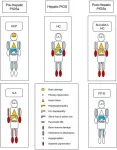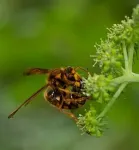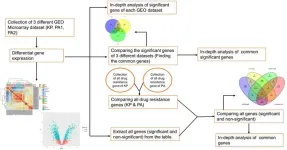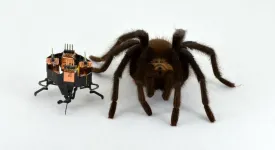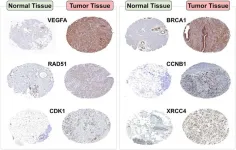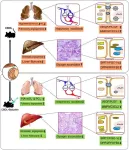A revised classification of primary iron overload syndromes
2024-04-29
(Press-News.org) Background and Aims
The clinical introduction of hepcidin25 (Hep25) has led to a more detailed understanding of its relationship with ferroportin (FP) and divalent metal transporter1 in primary iron overload syndromes (PIOSs). In 2012, we proposed a classification of PIOSs based on the Hep25/FP system, which consists of prehepatic aceruloplasminemia, hepatic hemochromatosis (HC), and posthepatic FP disease (FP-D). However, in consideration of accumulated evidence on PIOSs, we aimed to renew the classification.
Methods
We reviewed the 2012 classification and retrospectively renewed it according to new information on PIOSs.
Results
Iron-loading anemia was included in PIOSs as a prehepatic form because of the newly discovered erythroferrone-induced suppression of Hep25, and the state of traditional FP-D was remodeled as the BIOIRON proposal. The key molecules responsible for prehepatic PIOSs are low transferrin saturation in aceruloplasminemia and increased erythroferrone production by erythroblasts in iron-loading anemia. Hepatic PIOSs comprise four genotypes of HC, in each of which the synthesis of Hep25 is inappropriately reduced in the liver. Hepatic Hep25 synthesis is adequate in posthepatic PIOSs; however, two mutant FP molecules may resist Hep25 differently, resulting in SLC40A1-HC and FP-D, respectively. PIOS phenotypes are diagnosed using laboratory tests, including circulating Hep25, followed by suitable treatments. Direct sequencing of the candidate genes may be outsourced to gene centers when needed. Laboratory kits for the prevalent mutations, such as C282Y, may be the first choice for a genetic analysis of HC in Caucasians.
Conclusions
The genetic background of PIOS differs in Caucasians and non-Caucasians.2 Therefore, physicians have to overcome differences in the global prevalence of PIOS in clinical practice. The Hep25/FP system classifies PIOSs as prehepatic ACP and ILA, hepatic HC, and posthepatic SLC40A1-HC and FP-D. The revised classification for PIOSs may be useful worldwide.
Full text
https://www.xiahepublishing.com/2310-8819/JCTH-2023-00290
The study was recently published in the Journal of Clinical and Translational Hepatology.
The Journal of Clinical and Translational Hepatology (JCTH) is owned by the Second Affiliated Hospital of Chongqing Medical University and published by XIA & HE Publishing Inc. JCTH publishes high quality, peer reviewed studies in the translational and clinical human health sciences of liver diseases. JCTH has established high standards for publication of original research, which are characterized by a study’s novelty, quality, and ethical conduct in the scientific process as well as in the communication of the research findings. Each issue includes articles by leading authorities on topics in hepatology that are germane to the most current challenges in the field. Special features include reports on the latest advances in drug development and technology that are relevant to liver diseases. Regular features of JCTH also include editorials, correspondences and invited commentaries on rapidly progressing areas in hepatology. All articles published by JCTH, both solicited and unsolicited, must pass our rigorous peer review process.
Follow us on X: https://twitter.com/xiahepublishing
Follow us on LinkedIn: https://www.linkedin.com/company/xia&he-publishing-inc/
END
ELSE PRESS RELEASES FROM THIS DATE:
2024-04-29
INDIANAPOLIS – Clinical trials are constantly being designed and study participants enrolled to determine if medical treatments and therapies are safe and effective. Much has been written about the importance of including diverse populations in these trials.
However, the nearly 1.4 million individuals who live in the 15,600 nursing homes across the U.S. have been largely left out of clinical trials, despite the prevalence of such common conditions as hypertension, depression, diabetes and Alzheimer’s disease in this population.
A commentary by faculty of Regenstrief Institute, Indiana University, UCLA ...
2024-04-29
Background and objectives
Infectious diseases caused by pathogenic strains of bacteria are a global cause of morbidity and mortality. Hospital-acquired infections caused by Klebsiella pneumonia and Pseudomonas aeruginosa were found vulnerable during the COVID-19 pandemic. They are also responsible for the onset of certain life-threatening infectious diseases such as cystic fibrosis, endocarditis, bacteremia, and sepsis. Looking into the importance of these two superbugs there is a strong need for extensive comparative differential gene expression analysis ...
2024-04-29
WASHINGTON, DC – (April 26, 2024) The effects of quantum mechanics—the laws of physics that apply at exceedingly small scales—are extremely sensitive to disturbances. This is why quantum computers must be held at temperatures colder than outer space, and only very, very small objects, such as atoms and molecules, generally display quantum properties. By quantum standards, biological systems are quite hostile environments: they’re warm and chaotic, and even their fundamental components—such as cells—are considered very large.
But ...
2024-04-29
New York, NY [April 29, 2024]—Miriam Merad, MD, PhD, a world-renowned immunologist, has been appointed Dean for Translational Research and Therapeutic Innovation of the Icahn School of Medicine at Mount Sinai. The appointment reaffirms Icahn Mount Sinai’s commitment to pioneering medical progress and catalyzing the rapid advancement of research innovation.
Dr. Merad, the Mount Sinai Professor in Cancer Immunology, will also continue to serve as the founding Chair of the Department of Immunology and Immunotherapy, Director of the Marc and Jennifer Lipschultz Precision Immunology Institute, and Director ...
2024-04-29
Category 4 Hurricane Ian made landfall in Florida’s Lee County on Sept. 28, 2022, battering the region with wind speeds of 155 miles per hour and storm surge up to 13 feet – the highest storm surge documented in Southwest Florida in the past 150 years.
In the aftermath of a disaster, rapidly assessing damage is critical for rescue, recovery and emergency planning. Damage assessments are typically conducted through field reconnaissance deployments, which can be labor-intensive, costly and risky. Moreover, field-based emergency response ...
2024-04-29
The question may be the 21st century’s version of the fable of the tortoise and the hare: Who would win in a foot race between a robot and an animal?
In a new perspective article, a team of engineers from the United States and Canada, including University of Colorado Boulder roboticist Kaushik Jayaram, set out to answer that riddle. The group analyzed data from dozens of studies and came to a resounding “no.” In almost all cases, biological organisms, such as cheetahs, cockroaches and even humans, seem to be able to outrun their robot counterparts.
The researchers, led by Samuel Burden at the University of Washington and ...
2024-04-29
NEW YORK, April 29, 2024 – The Human Immunome Project (HIP), a global nonprofit scientific initiative, released its Scientific Plan today, on World Immunology Day, the organization announced. The plan provides a detailed roadmap of how the Human Immunome Project and its network of global study sites will generate the world’s largest and most diverse immunological dataset and use these data to power publicly available AI models of the immune system.
“The immune system is the epicenter of human health, and our newly released ...
2024-04-29
Highlights:
The American Heart Association awarded four new scientific research grants to evaluate the role of race in measuring heart disease risk.
The funded studies are focused on multi-ethnic groups and studying how race, considered a social rather than biological construct, affects health risk prediction when it is incorporated as a variable in algorithms.
This research is funded by a grant from the Doris Duke Foundation to study the complex issue of how race and ethnicity, when factored into cardiovascular clinical care algorithms ...
2024-04-29
Background and objectives
Breast cancer remains a significant global health concern, warranting further exploration into its genetic basis and potential therapeutic targets. This study aimed to elucidate the genetic associations of seven pivotal genes with breast cancer and discern their potential role in disease prognosis.
Methods
The genes VEGFA, BRCA1, RAD51, CCNB1, CHEK1, CDK1, and XRCC4 were curated from over 30 articles. Their association with breast cancer was analyzed using both in silico and in vitro techniques. The in silico assessment ...
2024-04-29
Background and Aims
Hepatopulmonary syndrome (HPS) is characterized by arterial oxygenation defects due to pulmonary vascular dilation in liver disease. To date, liver transplantation remains the only effective treatment for HPS. This study aimed to explore the preventative role of baicalein in HPS development.
Methods
Sixty male rats were randomly assigned to three groups: sham, common bile duct ligation (CBDL), and baicalein, receiving intraperitoneal injections of baicalein (40 mg·kg−1·d−1, diluted in saline) for 21 days. Survival rate, liver and kidney function, and bile acid metabolism levels were evaluated. Liver and lung angiogenesis ...
LAST 30 PRESS RELEASES:
[Press-News.org] A revised classification of primary iron overload syndromes
